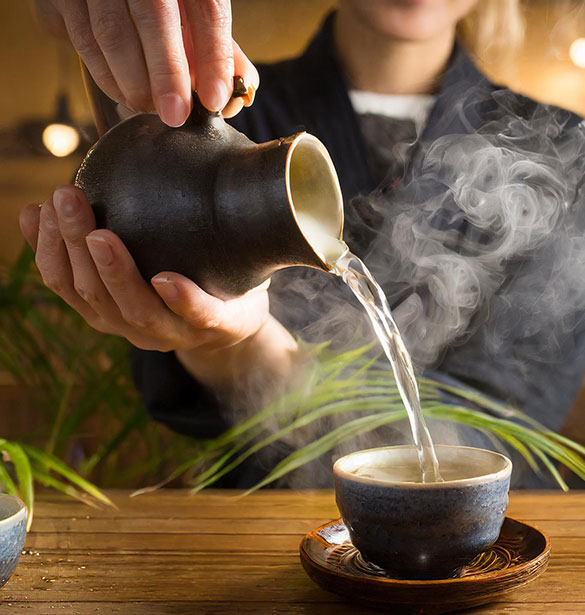
Warm sake, why and which one should you drink?
We are proud to exclusively present premium sake. Therefore, we generally recommend that you enjoy our sake chilled. However there are certain occasions to enjoy some of our bottlings warm. Here we will explore some of the guidelines for warming sake...
Why choose warming Sake?
Warm Sake stimulates your senses and your soul. It feels soft on the palate and creates a relaxing sensation. Erikem Kaibara (1630-1714), a Japanese doctor, once said, “A warm sake is more nourishing than a cold one." Unfortunately, warm Sake has a bad image since only industrial sake used to be served heated.
Warming Sake is a whole new world of flavors and traditions.
Here’s why you should try it:
- Umami Boost:
Heating sake brings out the savory flavors, perfect for hearty dishes like grilled meats or hot pots. - Winter Warmth:
A warm cup of atsukan is Japan’s answer to mulled wine, great for cold evenings. - History:
For generations warming sake covered up flaws in rougher brews. Now it brings out the complexity in high-end sakes like Junmai or Honjozo.
Which Sake to warm?
Not all Sake are created equal. Here are our favorite picks:
- ✅ Best to Warm:
Junmai (pure rice, no added alcohol) and Honjozo (slightly fortified with a solid structure) and Aged Koshu (which develops caramel-like flavors). - ❌ Chill These:
Ginjo/Daiginjo (the aromas will disappear) and sparkling sake (it loses its fizz).
Insider Tip: Look for the label “熱燗向き” (atsukan-muki) which means it’s suitable for warming.
How does warming change the flavor?
In general, the flavor opens up and it becomes richer and softer. The alcohol tastes drier and the sweetness and Umami become intensified. Bitterness and acidity, on the other hand, almost disappear.
Controlled heating changes Sake in some interesting ways:
- Aroma:
It becomes more subtle, with roasted rice or nutty notes replacing floral scents. - Mouthfeel:
It becomes smooth and silky as the alcohol softens. - Flavor:
Sweetness becomes more pronounced, umami deepens (think miso or dried mushrooms) and acidity mellows out for a smoother finish. - Caution:
Don’t overheat it (more than 55°C/131°F) as this will bring out harsh alcohol flavors—like overcooking wine.
How to warm Sake:
- Traditional Method:
The most traditional method of warming sake, which is also what we recommend, is to pour the sake into a heat resistant carafe and heat it up in a waterbacth to a temperature of 80 ° C for about 1-2 minutes. This should result in the sake becoming pleasantly warm without exceeding 50 ° C. - Modern Methods:
For a quick option, use a microwave: heat for 15–20 seconds per 180ml in a microwave-safe cup (stir for even warming). An electric warmer set to 50°C (122°F) can also do the trick.
Serving Tips: Use small cups (ochoko) and pair with umami-rich dishes like miso-glazed eggplant or yakitori.
Last Word: Try it out! Try our Junmai Genshu chilled and then warmed — you’ll find two different masterpieces in one bottle.
Which sake from our portfolio can one enjoy warm?
Full-bodied and less aromatic sake are ideal as a general
rule of thumb, but on our homepage you can find specific recommendations
to enjoy warm.
Here are some guidelines for enjoying warm sake:
The temperature should not exceed 55 ° C. Somewhere between 40 ° C (called Nuru-Kan in Japan) and 50 ° C (called Atsu-Kan in Japan) is the best range for warm sake.
Do you prefer to drink warm or cold Sake?
Find out what sake and which temperature and season suits you best to decide if you prefer to drink warm or cold sake.
Kanpai!
